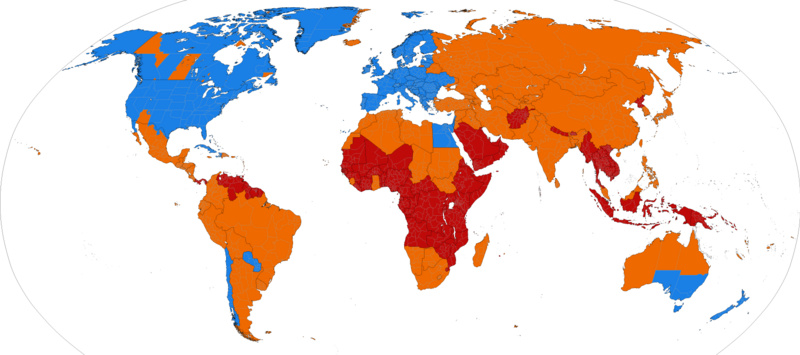This post has become necessary because it has come to my attention that many don't know exactly what the ST or DT mean in EST/CST/MST/PST and EDT/CDT/MDT/PDT. This can cause quite a lot of confusion when trying to organize events and make sure that there are no conflicts.
For reference, a lot of this information can be found in Wikipedia's Daylight Saving Time Article
The basic way that Daylight Saving Time works is you move your clock forward one hour in the Spring and move your clock backward one hour in the Fall. This is where we get the "Spring ahead" and "Fall behind" phrases.
Below is a picture that illustrates which areas of the world use Daylight Saving Time and which areas do not. The blue represents areas that use it, the orange represents areas that used to use it, and the red represents areas that never used it.

Below is a pic (or link if the pic doesn't work) that shows time zones around the world in "Standard Time". Remember, Standard Time is the time from Fall to Spring. This means that if you're in the US, "Standard Time" would be from the first Sunday in November til the second Sunday in March. "Daylight Time" however is the time from the second Sunday in March til the first Sunday in November. For example, from Nov > Mar areas in the Eastern part of the US located in the "Eastern Time" zone are GMT-5 and use the "Eastern Standard Time". But, those same areas in the "Eastern Time" zone are GMT-4 from Mar > Nov and follow "Eastern Daylight Time".
Wikipedia said:
Since 2007, daylight saving time starts on the second Sunday of March and ends on the first Sunday of November, with all time changes taking place at 02:00 local time.
http://upload.wikimedia.org/wikipedia/commons/0/01/2007-02-20_time_zones.svg
Wikipedia said:
Time zone names typically change when DST is observed. American English replaces standard with daylight: for example, Pacific Standard Time (PST) becomes Pacific Daylight Time (PDT). British English uses summer: for example, Greenwich Mean Time (GMT) becomes British Summer Time (BST). Abbreviations do not always change: for example, many (though not all) Australians say that Eastern Standard Time (EST) becomes Eastern Summer Time (also EST).
Now then, this brings us to an interesting point. Have you ever noticed when the server message says there's going to be maintenance from like 11:00 PDT to 13:00 PDT? Well, that "PDT" means Pacific Daylight Time and is GMT-7 from Mar > Nov which is MST or Mountain Standard Time from Nov > Mar.
Wikipedia said:
Time zone names typically change when DST is observed. American English replaces standard with daylight: for example, Pacific Standard Time (PST) becomes Pacific Daylight Time (PDT). British English uses summer: for example, Greenwich Mean Time (GMT) becomes British Summer Time (BST). Abbreviations do not always change: for example, many (though not all) Australians say that Eastern Standard Time (EST) becomes Eastern Summer Time (also EST).

^ is an advertisement that was used in the U.S. during 2001. The date is inaccurate, but I thought it was a funny pic to close with.







